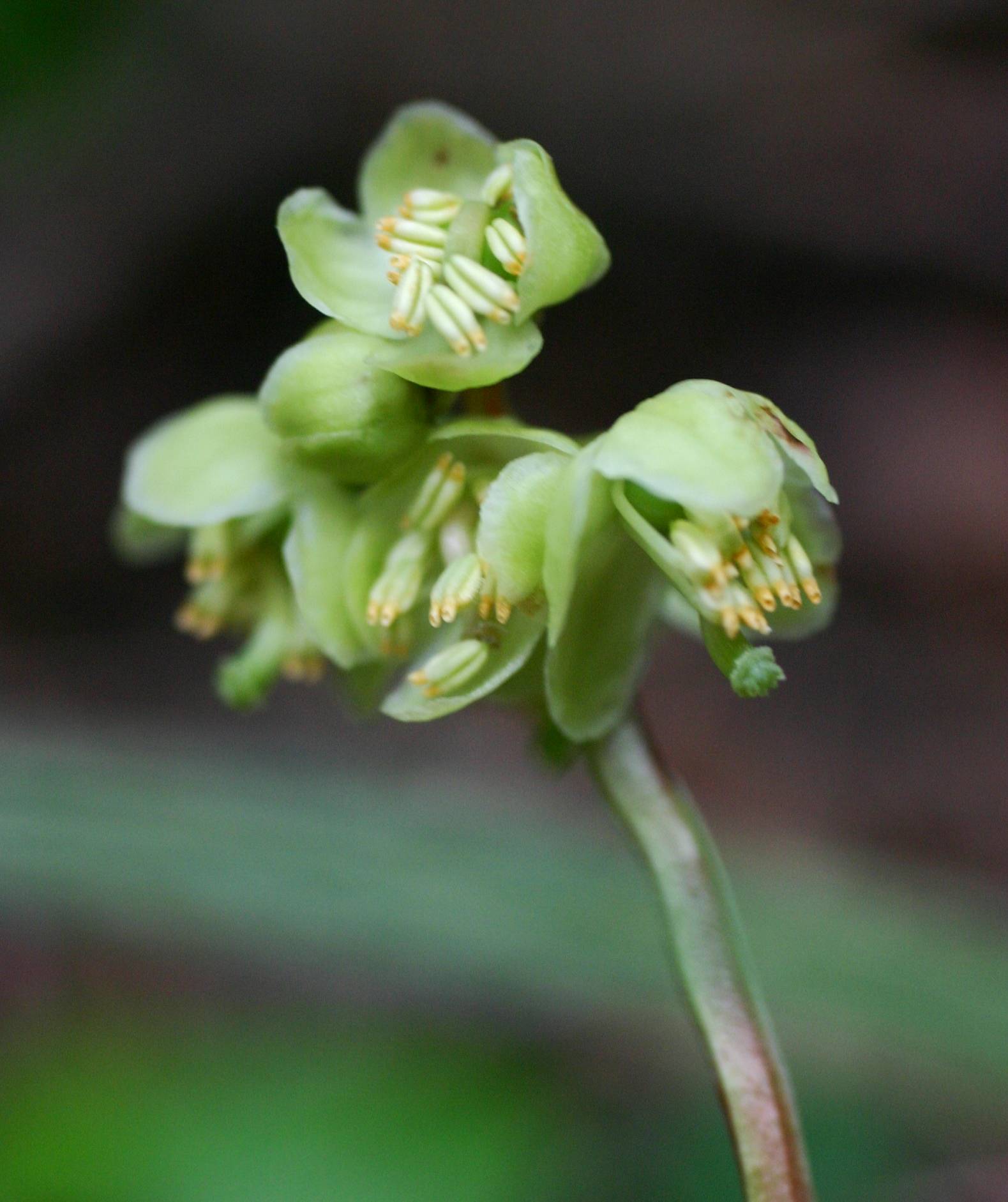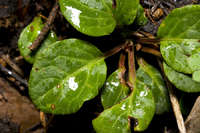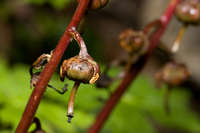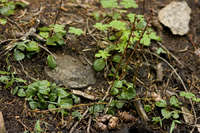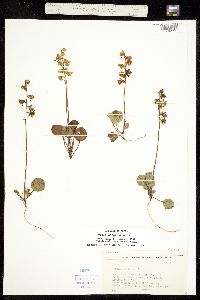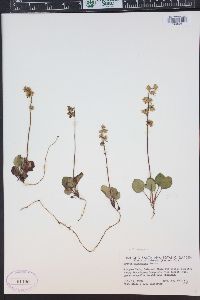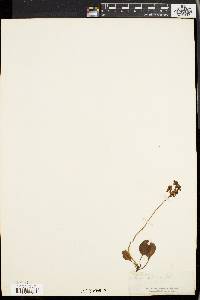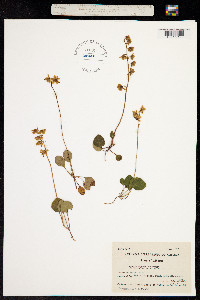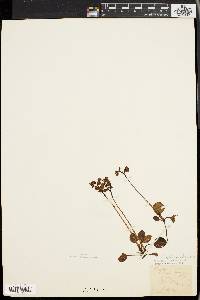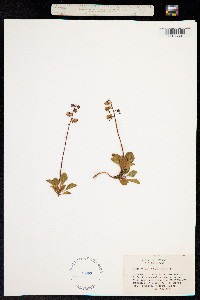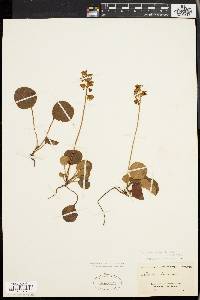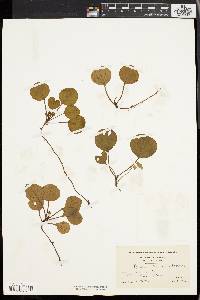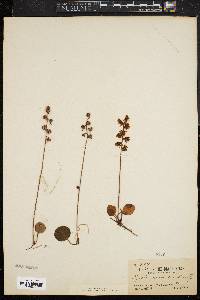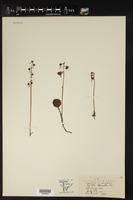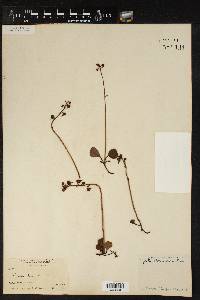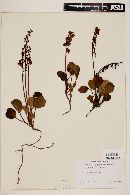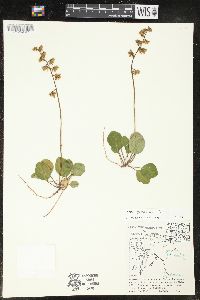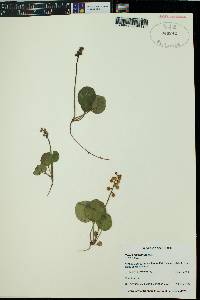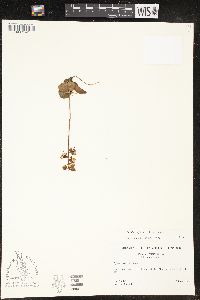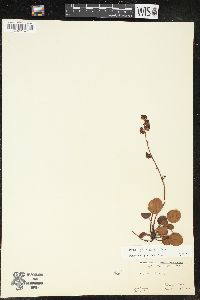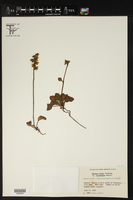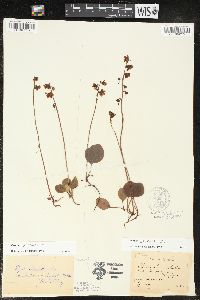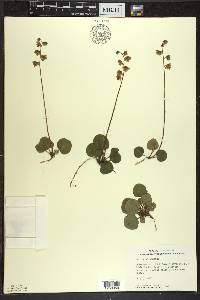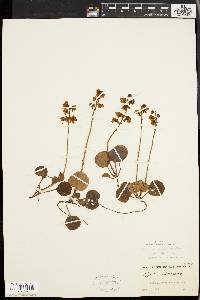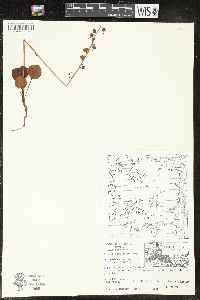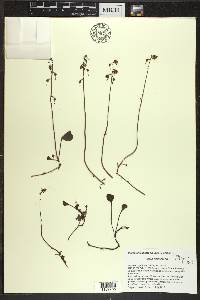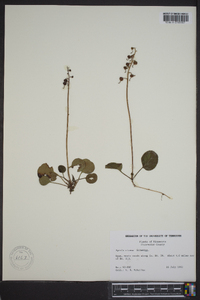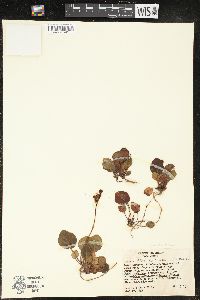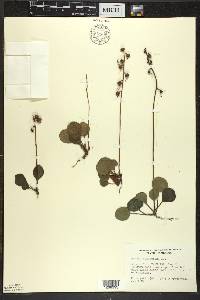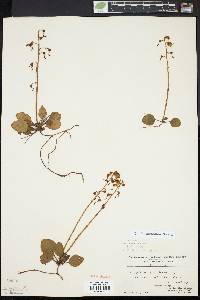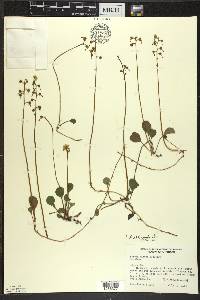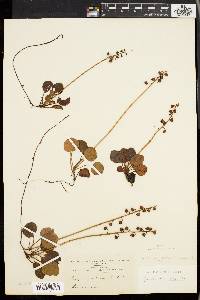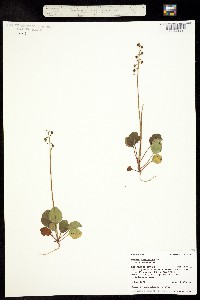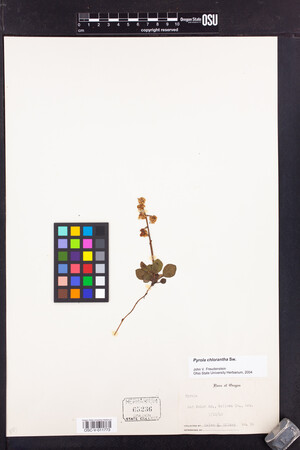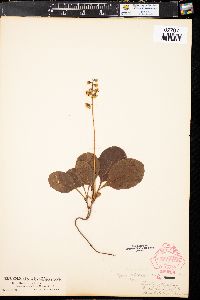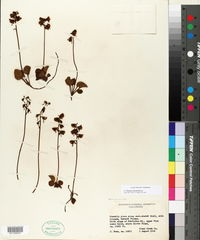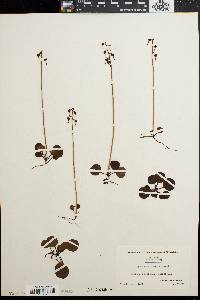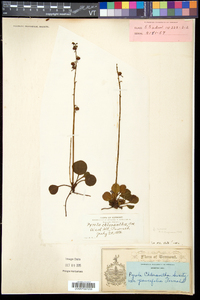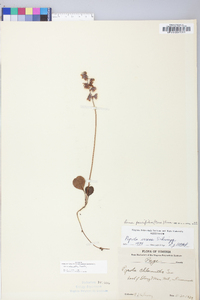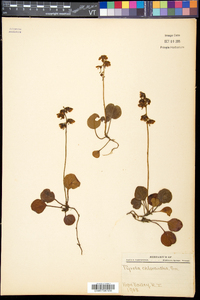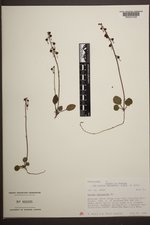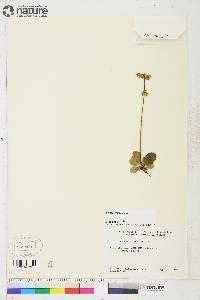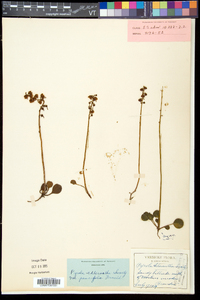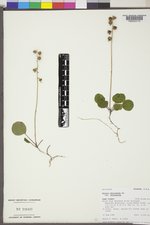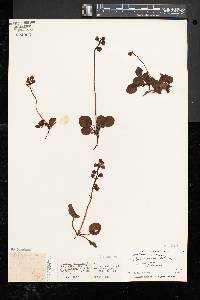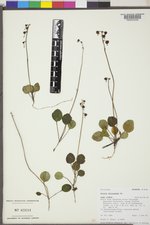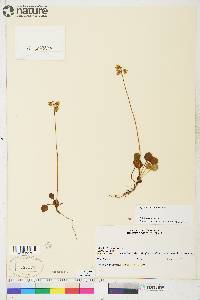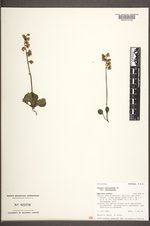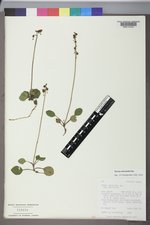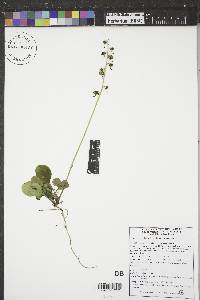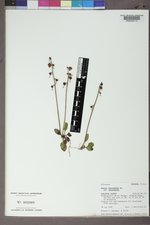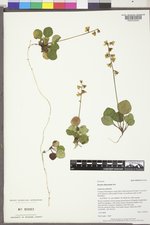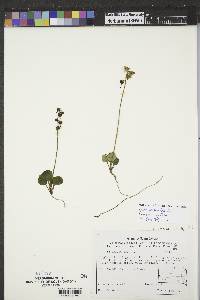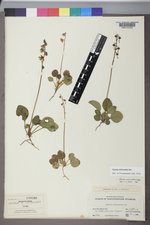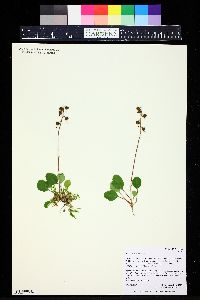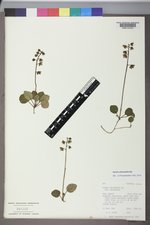
|
|
|
|
Family: Ericaceae
Green-Flower Wintergreen, more...greenflowered wintergreen, green shinleaf, wintergreen
[Pyrola chlorantha var. convoluta (W. Bart.) Fern., morePyrola chlorantha var. paucifolia Fern., Pyrola chlorantha var. revoluta Jennings, Pyrola convoluta W. Bart., Pyrola oxypetala Austin ex A. Gray, Pyrola virens Schweigg., Pyrola virens var. convoluta (W. Bart.) Fern., Pyrola virens var. saximontana Fern.] |
Plants rhizomatous, (0.7-)1.4- 2.2(-2.7) dm. Leaves sometimes reduced or absent; petiole 8-60 mm, channeled adaxially, glabrous; blade not or, rarely, obscurely maculate, dull and light green to purplish abaxially, shiny and dark green, rarely with white tissue bordering larger veins adaxially, ovate, elliptic, obovate, or round, (6-)18-28(-33) × (5-)10-30 mm, coriaceous, base rounded to truncate or decurrent, margins entire or crenulate to crenulate-serrulate, apex obtuse to rounded. Inflorescences 1-2(-3) per stem, (1-)2-8(-17)-flowered; peduncular bracts absent or 1(-2), subulate to linear-lanceolate, 2.8-5 × 0.5-0.8 mm, membranous, margins entire or erose-denticulate; inflorescence bracts subulate to lanceolate, usually shorter than, rarely longer than, subtended pedicels, (2.3-)3-5(-7.7) × 0.5-0.8 mm, membranous. Pedicels 3-8 mm. Flowers: calyx lobes appressed or spreading in fruit, green or pinkish with margins hyaline to white, deltate to deltate-ovate, (0.9-)1.2-1.7 × (0.9-)1.3-1.9 mm, margins entire or obscurely erose-denticulate, apices acute to obtuse; petals greenish white to yellowish white, obovate, (4-)4.5-9 × 3.3-5.5 mm, margins entire or obscurely erose-denticulate; stamens 4-7.5 mm; filament base 0.7-1.2 mm wide; anthers (2.1-)2.5-3(-3.7) mm, apiculations absent or less than 0.1 mm, thecae creamy white or tan to yellowish, tubules yellowish brown, 0.7-1.1 mm, abruptly narrowed from thecae, lateral walls not touching or connivent distally, pores 0.2-0.4 × 0.1-0.2 mm; ovary smooth; style exserted, (4-)5-7 mm; stigma 0.9-1.5 mm wide, lobes erect. Capsules depressed-globose, 3-4.5 × 3.5-6.4 mm. 2n = 46. Flowering Jun-Aug. Moist to dry, coniferous and deciduous forests; 10-3700 m; St. Pierre and Miquelon; Alta., B.C., Man., N.B., Nfld. and Labr., N.W.T., N.S., Nunavut, Ont., P.E.I., Que., Sask., Yukon; Alaska, Ariz., Calif., Colo., Conn., Del., Idaho, Maine, Md., Mass., Mich., Minn., Mont., Nebr., Nev., N.H., N.J., N.Mex., N.Y., Ohio, Oreg., Pa., R.I., S.Dak., Utah, Vt., Va., Wash., W.Va., Wis., Wyo.; Europe. E. Haber (1993) interpreted some herbarium specimens with intermediate morphologies and abnormal pollen as putative hybrids between Pyrola chlorantha and P. minor, and between P. chlorantha and P. picta. Leafless forms of P. chlorantha can be distinguished reliably from those of P. picta by the size and shape of the calyx lobes.
Plant: perennial rhizomatous, scapose herbs Leaves: blades ovate-elliptic, obovate or reduced to bracts, generally under 2.5 cm long; petioles shorter than to several times the blade length INFLORESCENCE: glabrous symmetric bracteate racemes Flowers: with sepals broadly ovate, 1.2-1.6 mm long, tips acute to mainly obtuse; petals pale green, drying dull olive with yellow margin, mainly 5-7 mm long; anthers 2-3(-4) mm long, the tubes relatively prominent, curved with pores at ends Misc: Coniferous forest; 1900-3100 m (6500-10500 ft); Jun-Jul Notes: scapes mainly 14-22 cm tall REFERENCES: Haber, Erich. 1992. Pyrolaceae. Ariz.-Nev. Acad. Sci. 26(1)2. General: Perennial, evergreen, 5-25 cm tall; scapes erect; herbage glabrous; rhizomes long. Leaves: Basal, alternate, crowded, broadly elliptic, obovate to sub-rotund, 1-3 cm long, 0.5-3 cm wide, glabrous, leathery, margins entire or minutely dentate, base rounded to wedge-shaped, apex rounded to truncate; petiole mostly 1.5-3 cm long. Flowers: Inflorescence a raceme, secund (one-sided), 6-20 flowered; pedicels 3-5 mm long, curved and remaining so in fruit; sepals 5, somewhat orbicular to ovate, 0.5-1.3 mm long, the margins finely and irregularly toothed; petals 5, 4-6 mm long, white to greenish; stamens 10, the anthers opening by apical pores, inverting before flowering and appearing basal; ovary subtended by a nectar disk with 10 minute glands; style straight or nearly so, 3-5.5 mm long, the stigma peltate, 5-lobed; flowers July-August. Fruits: Loculicidal capsule, 3.5-7 mm long; seed numerous, minute. Ecology: Coniferous forests; 2000-3200 m (6500-10500 ft); Apache, Cochise, Coconino, Graham, Greenlee, and Pima counties; Canada, northeastern, north-central, western, and southwestern U.S. Notes: Pyrola elliptica (waxflower shinleaf ) is distinguished by its broadly elliptic, oblong, or ovate, soft-textured leaves, 3.5-5.5 cm long, usually longer than the petiole. Pyrola minor (little shinleaf, snowline wintergreen) has radial flowers, the petals white or pinkish, and a short, straight style, not exserted from the corolla. Both P. elliptica and P. minor occur in similar habitats as P. chlorantha. Pyrola chlorantha is used by the Navajo to stop bleeding and to treat bloody diarrhea in infants. Editor: Springer et al. 2008 Lvs 1-3(-4) cm, often shorter than the petiole, obovate to broadly elliptic or subrotund, rounded to truncate at the summit, rounded to broadly cuneate at base but scarcely decurrent, seldom ±reduced or even wholly suppressed; scapes 1-2.5 dm, seldom with more than 10 fls; sep broadly ovate-triangular, broader than long, obtuse or subacute; pet 4-9 mm, white, ±veined with green; anther-tubes abruptly narrowed from the pollen sacs and of different color, prolonged 0.6-0.8 mm and usually separate, often curved; style declined; 2n=46. Dry woods; circumboreal, in Amer. s. to Md., W.Va., Ind., and the w. cordillera. June-Aug. (P. virens; P. oxypetala) Gleason, Henry A. & Cronquist, Arthur J. 1991. Manual of vascular plants of northeastern United States and adjacent Canada. lxxv + 910 pp. ©The New York Botanical Garden. All rights reserved. Used by permission. From Flora of Indiana (1940) by Charles C. Deam A specimen of this species was collected by Hill, May 25, 1878, in sandy woods near Whiting, Lake County. It is in the herbarium of DePauw University. It has more recently been collected by Nieuwland & Just in a tamarack swamp on the north side of Bass Lake, St. Joseph County, June 18, 1930. The specimens are very young but seem to be sufficiently distinct. Both specimens belong to the typical form. …… Indiana Coefficient of Conservatism: C = 10 Wetland Indicator Status: FACU |
This project was made possible in part by the Institute of Museum and Library Services [MG-70-19-0057-19].
Powered by Symbiota

